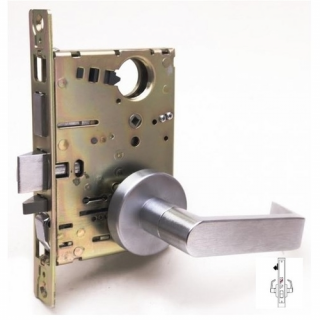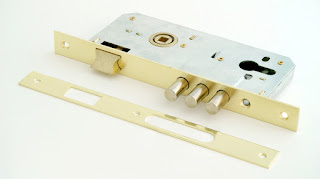What is a Mortise Lock - Here’s a Detailed Guide
A mortise lock is a door or window hardware component which can be locked with a key, or in some cases, manually, by pushing it in. This type of lock is installed into the door frame and is commonly used on doors that are not wide enough for a rim latch to operate smoothly.
While there are many different types of locks available on the market
today for both residential and commercial applications, mortise locks
have been around for centuries and stood their ground among more modern
types of locksmithing techniques with ease.
The mortise lock is a unique locking mechanism that relies on several
distinct parts in order to function properly. There are two main types
of mortise locks, the Deadbolt, and the Passage Lock. Both of them have
their pros and con’s and it all comes down to your specific needs at
home or in the office when choosing the right lock for you.
This article will cover the basic parts of a mortise lock, what they do,
how they do what they do, and most importantly how many different types
there are so you can make sure that you get exactly what you need.
How Mortise Locks Work
When it comes to mortise locks, there are a lot of parts that make it
what it is. The Locking Mechanism is the first part of this system to
consider. When it comes to mortise locks, there are two main types of
locking mechanisms. There are rim locks and cam locks. The difference
between the two is that one slides and one rotates in order to lock and
unlock the device, respectively. Both of these actions require the use
of an actuator in order to function properly. If you’ve seen a deadbolt
before, you will know that it consists of a horizontal bolt that moves
up and down when locked or unlocked.
This is called a rim lock actuator. The second type of mortise lock, cam
locks, has an actuator that rotates or revolves. The difference between
the two lies in the lift mechanism. In a deadbolt, it doesn’t require
much force for the bolt to engage with the locking point in order to
lock it into place. On the other hand, cam locks differ from the
deadbolt in one way; they are mounted at an angle and are usually
slotted at 90 degrees so that when you turn it over, it will move
vertically and release itself from being lifted.
This action is known as a cam lock. In addition to the two main types of
locks, mortise locks have other parts as well. The pins and wedges in
the mortise door lock consist of a linkage that links the bolt to the locking point, providing movement on one end and resistance on the other end.
Once you place your key into the lock, there are three different ways
that it can be turned, or operated. It either turns clockwise when
operated manually, or it can be rotated counter-clockwise if operated
electrically. Lastly, there are locks that operate by using a cylinder
which is a series of pin-tumblers that can be turned to open the lock.
There are many different parts in mortise locks and it’s important to
know what each one does. The next page will cover the parts of the
mortise lock, and how they are used.
Mortise Lock Parts
When it comes to mortise locks, there are quite a few different parts
that make them possible to be used for so many different applications.
For instance, the deadbolt is commonly used for doors that are too
narrow for rim locks because they have such small space on either side
of their surface. On the other hand, the passage lock is used for doors
that are wider than normal but want to still provide security for their
users.
In terms of the different parts that make up each type of mortise lock,
there are three that are arguably the most important ones. They include
Pin, Latch, and Bolt. The first two contain a series of pins that can be
made in many different sizes and quantities so as to accommodate a wide
range of door sizes. In most instances, passage locks use door wedges
whereas deadbolts use larger wedges for extra security purposes.
How to pick the right mortise lock
Now that you’re aware of what a mortise lock is, you probably want to
know how to pick the right one for your home or office. Well, it’s not
as difficult as you think.
Here are the three criteria that you need to consider in order to get the right lock;
The Door or Window Size: This is probably the most
important factor in determining which type of mortise locks will work
best for you. For example, if your door is too narrow or too small, a
deadbolt will be more suitable for it than a passage lock because the
deadbolt has a smaller overall size. As far as standard doors go, both
of them should be equally capable of providing adequate security and
usability.
The Locking Mechanism: The deadbolt is more suitable
for indoor use whereas the passage lock has better applications in
outdoor environments. The Deadbolt can only be locked and unlocked in
one way, while the cam lock can be rotated if you want to unlock it from
the outside. The locking mechanism is in place to prevent any kind of
unauthorized entry so that you don’t have to worry about anyone coming
into your house or office when you’re not there.
Security: Whenever people buy a lock, one of the
biggest concerns they have is how secure it is. Once again, this mainly
depends on what type of door or window you are attaching it to and what
your main security concerns are.
About Park Avenue Locks
Choosing the right door lock for your business or home can be stressful.
At Park Avenue locks, we strive to make it as easy as possible by
breaking down your options and offering a wide selection to fit your
style. Some of our best-selling products include emtek mortise lock,
yale locksets, lcn door closers, electric strikes, door hinges, and
other door accessories. Get the best door lock brands all in one
location for affordable pricing, whether you’re a custom home builder or
a homeowner when you shop with us. For all your door locks and
accessories, head over to Park Avenue Locks. We offer both residential
and commercial door locks at competitive prices and offer free shipping
on orders over $100.
For more information visit, https://www.parkavenuelocks.com/




Comments
Post a Comment